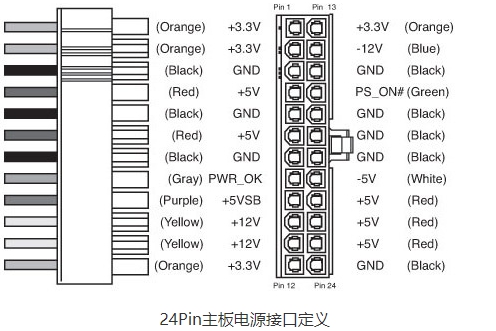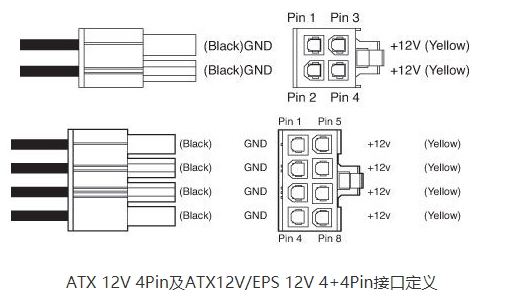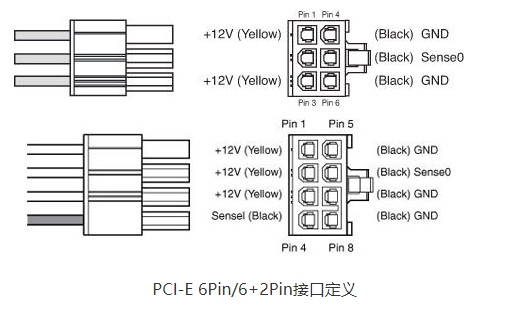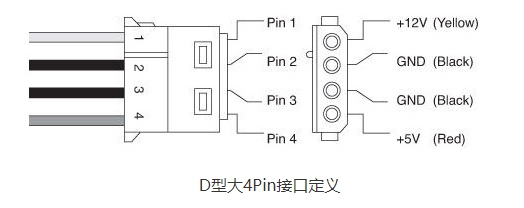Have you ever wondered what kind of interfaces are on the power supply?
Some players may think that what is the problem with this power interface, will anyone still not know? For players familiar with PC, this is of course not a problem, you can even close your eyes and connect the PC power correctly, but for For players who are just getting started, they may not even know how many interfaces the PC power supply has. At this time, it is very important to correctly understand the various interfaces of the PC power supply.
24Pin main power supply interface: the most important PC power supply interface
First of all, we start with the necessary interfaces for PC power supply. The first one to talk about is the largest 24Pin main power supply interface, which is also called the 24Pin motherboard power supply interface. It is so called because it is directly plugged into the motherboard. It is the most important PC power supply interface.
24Pin main power supply interface

24Pin motherboard power interface definition
The 24Pin main power supply interface of the power supply has 2 sets of +12V for 3 power, 5 sets of +5V power supply and 4 sets of +3.3V power supply. The maximum transmission current of each power supply is generally 6A, so the +12V, + of the 24Pin main power supply interface The maximum power of 5V and +3.3V power supply is 144W, 150W and 79.2W respectively.
It is worth noting that the current 24Pin main power supply interface is divided into two structures, one is an integral 24Pin, and the other is a separate 20+4Pin. The 24Pin main power supply interface of the two interfaces is suitable for the current motherboard. There is no difference in the above. The latter adopts a separate design mainly to be compatible with the old-fashioned motherboards that used the 20Pin power interface. However, such motherboards have long been eliminated by the market, so many power supplies now directly use the integrated design of the 24Pin main board. Power supply interface.
ATX 12V 4Pin and ATX12V/EPS 12V 4+4/8Pin interface: CPU power source
Because the +12V power supply provided by the 24Pin main power supply interface is limited, current CPUs use independent interfaces to obtain +12V power supply, and the power supply to the CPU is the ATX 12V 4Pin or EPS 12V 4+4/8Pin on the power supply. The interface is what we often call the CPU 4Pin/4+4Pin/8Pin power supply interface.
CPU 4+4Pin and CPU 8Pin power supply interface

ATX 12V 4Pin and ATX12V/EPS 12V 4+4Pin interface definition
There are three types of CPU power supply interfaces: 4Pin, 4+4Pin and 8Pin, among which 4+4Pin and 8Pin are essentially the same interface. The difference between them is only a separate design and an integrated design, which is due to compatibility considerations. , There is no difference in performance. The CPU 4Pin power supply interface includes two +12V power supplies, while the 4+4Pin/8Pin power supply has 4 sets of +12V power supplies. The maximum transmission current of each group of the former is generally 8A, and the maximum transmission current of each group of the latter is generally 7A. Therefore, the maximum power supply of the CPU 4Pin power supply interface is 192W, while the CPU 4+4Pin/8Pin power supply interface is 336W.
It is worth noting that because the CPU does not directly use +12V power supply, but needs to convert +12V into its own operating voltage through a switching power supply circuit, so there is still conversion efficiency, so some high-end processors can use the CPU 4Pin provides power supply, but considering the needs of stable work and overclocking, some high-end processors need to use 4+4Pin or 8Pin CPU power supply interface, the latter has more sufficient power supply, so when you assemble high-end platforms, be sure to Pay attention to the selected power supply and whether the motherboard provides 4+4Pin or 8Pin CPU power supply interface.
PCI-E 6Pin/6+2Pin interface: an important source of power supply for graphics cards
In the same way as the CPU power supply, the discrete graphics card is now not only taking power from the motherboard slot. In order to meet the high demand for power supply of the GPU, most of the mainstream or above graphics cards need to use external power supply, and this power supply interface is The familiar PCI-E power supply interface mainly includes 6Pin and 6+2Pin.
PCI-E 6+2Pin interface

PCI-E 6Pin/6+2Pin interface definition
PCI-E 6+2Pin power supply interface is essentially 8Pin power supply interface. It is also the difference between separate and integral. There is no difference in performance. It is only for compatibility and versatility considerations, so now there is basically only 6Pin and 6+2Pin two PCI-E graphics card power supply interfaces. The PCI-E power supply interface mainly provides +12V power supply. The PCI-E 6Pin power supply has 2 sets of +12V power supply, while the PCI-E 6+2Pin has 3 sets of +12V power supply. Generally speaking, each group can bear 8A power supply. The maximum output power of PCI-E 6Pin power supply is 192W, while PCI-E 6+2Pin has 288W.
However, this is the physical value of the maximum transmission power of PCI-E 6Pin and PCI-E 6+2Pin interfaces, and is not a limit value in the PCI-E specification. In fact, according to the requirements of the PCI-E specification, the power supply of a single PCI-E 6Pin shall not exceed 75W, and the power supply of a single PCI-E 6+2Pin/8Pin shall not exceed 150W. The numbers in these specifications are far smaller than the actual physical interface. Upper limit.
D-type large 4Pin interface and SATA power interface: the power supply of the hard disk and various peripherals depends on them
As mentioned above, the 24Pin main power supply interface, CPU power supply interface and PCI-E power supply interface are all large power supply users in PCs, and their correspondence is also the most important hardware in PCs. But in terms of usage, the D-type large 4Pin interface and SATA interface to be mentioned below are more extensive, because the power supply of hard disk and various peripherals basically depends on these two interfaces.
SATA power interface, floppy drive power supply interface, D-type large 4Pin interface
The D-type large 4Pin interface is the oldest existing interface in computers. It is manufactured and sold by Molex. The industry refers to it as the Molex interface. However, due to its large size and appearance, it looks a bit elongated. Subtitle D, so there are many names such as "big 4Pin" and "D4Pin", which is the most familiar power interface for players. Old-fashioned hard drives, optical drives and chassis fans all need to rely on it for power supply.

D type big 4Pin interface definition
The D-type large 4Pin interface can provide 1 set of +5V and 1 set of +12V power supply. Of course, players can also obtain +7V power supply by using +12V power supply and +5V as ground wire. The terminals used can withstand a maximum current of 13A. However, for safety reasons, there are related specifications that require that the actual power supply of each terminal should be controlled within 5A, so the D-type large 4Pin interface +12V power supply is 60W, and +5V is 25W.
By the way, it is the floppy drive interface commonly known as "small 4Pin". Its wiring method is basically the same as that of the D-type large 4Pin, but the volume is much smaller and the power supply is slightly lower. Because the floppy drive has been eliminated, many power supplies are now The product no longer provides this interface, so we won't elaborate on it here.

SATA power interface definition
The SATA power interface is currently the main power source for SATA hard drives, including HDD mechanical hard drives and SSD solid state drives. It can provide +12V, +5V, and +3.3V power supplies. Each set of voltage corresponds to 3 pins, totaling 15 pins. The current that can be transmitted by each terminal is 1.5A, so the current that can be transmitted by 12V, 5V and 3.3V is 4.5A, and the power is 54W, 22.5W and 14.85W respectively.
Since most SATA devices can work normally without +3.3V power supply, if players really need a large number of SATA power ports but the power supply itself is insufficient, then you can use an adapter cable from D-type 4Pin Interface transfer expansion.
















 RCCN WeChat QrCode
RCCN WeChat QrCode Mobile WebSite
Mobile WebSite